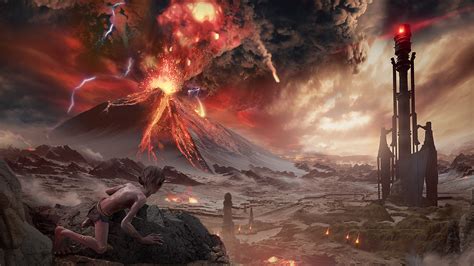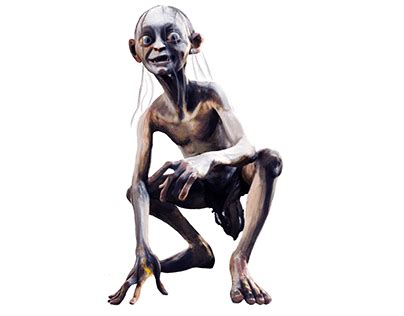Golem in Lord of Rings

The character of Gollum, also known as Sméagol, is one of the most complex and intriguing figures in J.R.R. Tolkien's Middle-earth legendarium, particularly in "The Lord of the Rings" trilogy. Gollum's story is a tragic tale of obsession, corruption, and the devastating consequences of the One Ring's influence. As a creature torn between his loyalty to his "precious" and his lingering sense of morality, Gollum embodies the dark side of the human condition, raising fundamental questions about the nature of addiction, the corrupting influence of power, and the blurred lines between good and evil.
Key Points
- Gollum's origins as Sméagol, a Stoor Hobbit, and his corruption by the One Ring
- The psychological struggle between Sméagol and Gollum, symbolizing the conflict between good and evil
- Gollum's role in the narrative of "The Lord of the Rings," including his encounters with Bilbo and Frodo Baggins
- The linguistic and cultural significance of Gollum's speech patterns and his use of the term "precious"
- The symbolic and thematic importance of Gollum in the context of Tolkien's work and the broader literary canon
The Evolution of Gollum: From Sméagol to the Servant of the Ring

Gollum’s transformation from Sméagol, a hobbit-like creature, to the wretched, Ring-obsessed being he becomes is a testament to the insidious power of the One Ring. The Ring, forged by the Dark Lord Sauron, is imbued with a will of its own, seeking to return to its master and fulfill its purpose of dominating and enslaving the peoples of Middle-earth. Sméagol’s discovery of the Ring in the river Anduin sets in motion a chain of events that will forever alter his existence, drawing him into a world of darkness and compelling him to commit acts of unspeakable cruelty.
Gollum’s Inner Conflict: The Struggle Between Sméagol and Gollum
One of the most compelling aspects of Gollum’s character is the internal conflict that ravages his being. The personas of Sméagol and Gollum represent two opposing forces: Sméagol, the vestiges of his former self, still capable of experiencing emotions like love, pity, and regret; and Gollum, the creature utterly consumed by his addiction to the Ring, driven by a singular desire to possess and protect it. This dichotomy is exemplified in Gollum’s peculiar speech patterns, where he often refers to himself in the third person, oscillating between “Sméagol” and “Gollum,” and addressing the Ring as “my precious.” This linguistic peculiarity underscores the fragmented nature of his psyche, torn between the remnants of his innocence and the corrupting influence of the Ring.
| Character Aspect | Description |
|---|---|
| Sméagol | The original hobbit-like creature, representing innocence and moral integrity |
| Gollum | The Ring-obsessed creature, symbolizing corruption and the destructive power of addiction |
| Precious | The term used by Gollum to refer to the One Ring, signifying its central role in his existence |

Gollum’s Role in “The Lord of the Rings”: A Guide and a Hindrance

Gollum’s encounters with Bilbo and Frodo Baggins are pivotal to the narrative of “The Lord of the Rings.” Initially, Gollum’s interactions with Bilbo in “The Hobbit” set the stage for the events of the trilogy, as Bilbo’s accidental discovery of the Ring and his subsequent riddle contest with Gollum lead to the Ring’s transfer to the Shire. Later, in “The Lord of the Rings,” Gollum’s role evolves as he becomes both a guide and a hindrance to Frodo, leading him through perilous landscapes towards Mordor while simultaneously plotting to reclaim the Ring for himself. This ambivalence underscores Gollum’s internal conflict and his ultimate failure to reconcile his dual identities, culminating in a tragic conclusion that is both poignant and devastating.
The Linguistic and Cultural Significance of Gollum’s Speech
Gollum’s unique speech patterns, characterized by his use of the term “precious” and his tendency to address himself in the third person, have become iconic in the world of fantasy literature. This peculiar language serves several purposes, including highlighting Gollum’s isolation and his obsessive relationship with the Ring. Furthermore, Gollum’s speech reflects the corrupting influence of the Ring, which has warped his perception of reality and distorted his linguistic expressions. The use of “precious” as a term of endearment for the Ring underscores the depth of Gollum’s obsession, illustrating the ways in which the Ring has become an integral part of his identity.
What is the significance of Gollum's character in "The Lord of the Rings"?
+Gollum's character serves as a symbol of the corrupting influence of the One Ring and the dangers of unchecked desire. His narrative arc illustrates the tragic consequences of becoming enslaved to one's obsessions and the enduring struggle between good and evil.
How does Gollum's speech reflect his internal conflict?
+Gollum's speech patterns, including his use of the term "precious" and his tendency to address himself in the third person, reflect his internal conflict between Sméagol and Gollum. This linguistic peculiarity underscores the fragmented nature of his psyche, torn between the remnants of his innocence and the corrupting influence of the Ring.
What role does Gollum play in the narrative of "The Lord of the Rings"?
+Gollum serves as both a guide and a hindrance to Frodo, leading him through perilous landscapes towards Mordor while simultaneously plotting to reclaim the Ring for himself. This ambivalence underscores Gollum's internal conflict and his ultimate failure to reconcile his dual identities.
In conclusion, Gollum’s character in “The Lord of the Rings” represents a profound exploration of the human condition, delving into themes of obsession, corruption, and the struggle between good and evil. Through his tragic narrative, Tolkien provides a nuanced commentary on the dangers of unchecked desire and the enduring power of the One Ring, leaving readers with a lasting impression of the devastating consequences of becoming enslaved to one’s obsessions.



